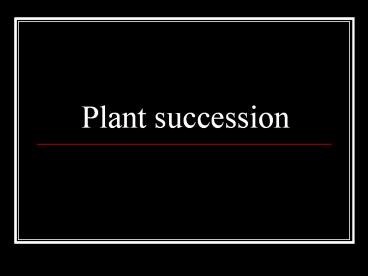Plant succession - PowerPoint PPT Presentation
1 / 21
Title: Plant succession
1
Plant succession
2
The Concept
- Succession is the natural, orderly change in
plant and animal communities that occurs over
time. If left undisturbed, an open field may
become an "aging" forest in 150-300 years.
However soil conditions, climate, permafrost,
topography, and natural and unnatural forces may
affect the pattern of succession
3
- Weather, fire, flood, insects, and human activity
can disrupt the forest, altering the pattern of
succession
4
The Stages
5
Herb Stage
- In this stage it contains seed plants whose stems
wither away to the ground each winter. - insects and small rodents feed on the grasses,
herbaceous plants, and seeds - As the diversity of plants increases so does the
variety of wildlife species.
6
Shrub Stage
- usually low woody plants with several permanent
stems instead of a single trunk - Larger variety of wild-life attracts predators
7
Young Forest Stage
- the quantity and diversity of shrubs and
herbaceous plants decreases - With less variety in food available, the number
of wildlife species decreases. - birds of prey nest in the trees of a young forest
8
Mature Forest Stage
- hardwood trees begin to die, opening the canopy
for the growth of spruce - Shrubs return and make more food and cover
available to songbirds, game birds, and rodents.
9
Climax Forest Stage
- dead trees called snags provide homes for
woodpeckers and other cavity-nesting birds.
Porcupines, squirrels, spruce grouse, and several
songbird species are typical of old stands of
spruce trees.
10
Types of Succession
- Primary
- Secondary
- Allogenic
- Autogenic
- Progressive
- Retrogressive
11
Primary
- Establishment of plants on land previously not
cultivated.
12
Secondary
- Invasion by plants on land that that was
previously vegetated. - Possible causes include natural or human such as
fire logging, cultivation or hurricanes
13
Allogenic
- Change in Environmental conditions
- E.g.. Salt marsh to woodland.
- The environmental changes the composition of the
plant community
14
Autogenic
- Where both plant community and environment change
- Caused by the activities of plants over time
- E.g.. Eruption of Mt. St.Helens
15
Progressive
- Where community becomes more complex with time
- Contains more species
- Contains more biomass over time.
16
Retrogressive
- The community regresses.
- Becomes more simplistic
- Contains fewer species and less biomass
- Some retrogressive successions are allogenic in
nature - E.g. Introduction of grazing animals results in
degradation of farmland.
17
The Facilitation Model
- "pioneer species" establish a presence on the
site of a disturbance. - They modify a site, for instance, by regenerating
the soil with organic material making the area
more attractive for invasion by other species. - Eventually, new species move in, edging out the
pioneers. - This process may repeat itself several times,
until the ecosystem reaches the climax stage.
18
The Tolerance Model
- all species involved in succession are equally
capable of establishing themselves on a recently
disturbed site - but those capable of attaining a large population
size quickly are likely to become dominant - Unlike the facilitation model, the tolerance
model does not depict earlier inhabitants as
preparing the site biologically. - this model is more akin to natural selection.
19
The Inhibition Model
- all species have equal opportunity to establish
populations after a disturbance - some of the early species actually make the site
less suitable for the development of other
species - An example of this is when plants secrete toxins
in the soil, thus inhibiting the establishment
and growth of other species
20
Climax
- When a biological community reaches a state of
stability and is in equilibrium with
environmental conditions - Dominant species in a climax community are those
that are tolerant of the biological stresses that
come with competition - frequent enough events of disturbance within
small sections of the biological community may
prevent climax from even occurring - Once reached change will slow down bringing an
end to the stages of succession. - Climax remains a theoretical notion.
21
What can cause Succession
- Seismic Events earthquakes, tidal waves, or
volcanic eruptions - hurricanes or tornadoes.
- the movement of glaciers or even of plates in
Earth's crust - wildfires or sudden infestations of insects
- Humans causes such as plowing up ground, logging,
clearance for construction even by causing
explosions on a military reservation or
battlefield

